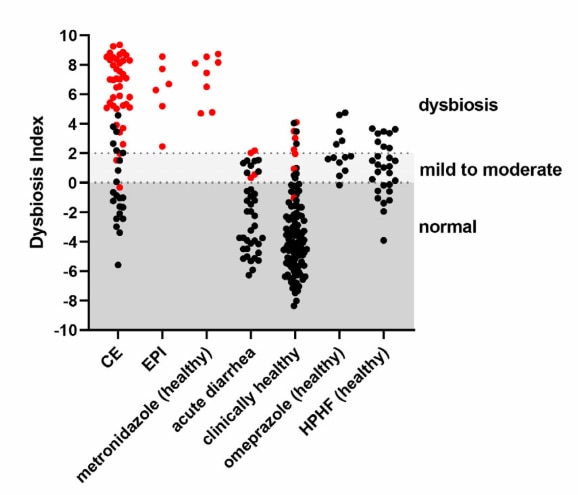
Gastrointestinal Disorders
Diagnosis and Clinical Interpretation of Intestinal Dysbiosis

Jan S. Suchodolski
Dr. med. vet., PhD, AGAF, DACVM
Texas A&M University
College Station, Texas, USA
Q. What are potential options for assessing the microbiome in clinical practice?
A.
- As the majority of fecal bacteria are strict anaerobes requiring specialized media, routine bacterial culture is not useful, and a study showed no agreement between different laboratories.1
- Next-generation sequencing is useful in research studies, but lacks reproducibility for assessment of individual patients.
- Dysbiosis Index (DI) is a commercially available PCR-based assay that quantifies core bacteria, and accurately predicts global microbiome shifts in individual patients.2 The DI is interpreted together with the individual bacteria, especially the bile acid-converting Peptacetobacter (Clostridium) hiranonis, as a decrease in its abundance is a major contributor to dysbiosis (see Figure 1 for interpretation).3

Figure 1. Dysbiosis Index (DI) in dogs. Dogs in red have reduced abundance of Peptacetobacter (Clostridium) hiranonis, a beneficial bile-acid converting bacterium important for maintaining a normal microbiome. A DI above 2 (dogs) or 1 (cats) indicates a significant dysbiosis, while a DI between 0 and 2 (dogs) and 0 and 1 (cats) indicates mild–moderate microbiome shifts. A subset of dogs with chronic enteropathy (CE) has persistently increased DI with reduced P. hiranonis. Some dogs with acute diarrhea have a mild and transient (1–2 weeks) altered DI. Broad-spectrum antibiotics induce dysbiosis that normalizes within 2–4 weeks after therapy in most animals, but some may have persistent dysbiosis for several months. Omeprazole leads to a transient increase in the DI but with normal P. hiranonis, and the DI normalizes within 1–2 weeks after therapy. Also, some animals on very unbalanced home-made diets (e.g., high protein/high fat [HPHF] raw meat-based diets) may have an increased DI but with normal P. hiranonis.3
Published with permission from The Purina Institute Handbook of Canine and Feline Clinical Nutrition, 2023.
Q. Why is intestinal dysbiosis relevant to dogs and cats with chronic enteropathies (CE)?
A. Persistent dysbiosis is often seen in CE, and animals with non-specific clinical intestinal signs may also have an increased DI suggesting the presence of chronic intestinal dysfunction.4 The DI is also used to screen donors for fecal microbiota transplantation (FMT).
Q. What are potential management options for dogs and cats with CE and intestinal dysbiosis?
A. As dysbiosis is a common component of chronic intestinal disease, a multimodal therapy approach is often needed. An increased DI in CE may reflect the severity and chronicity of mucosal remodeling, and dysbiosis typically persists even in clinical remission. Therapy should always consist of dietary modification as the first-line treatment, which can then be combined as needed with additional strategies such as probiotics, prebiotics, FMT, and in very rare cases, antibiotics.
Related Tools and Content:
Intestinal Dysbiosis in Dogs and Cats
Diet modification is a key component of therapeutic plans for managing dogs and cats with intestinal dysbiosis.
Balance Is Everything: Maintaining a Healthy Gut Microbiome
Kelly S. Swanson, PhD, explains the importance of gut health, what dysbiosis means, and the value of using a synbiotic supplement.
Diagnostic Considerations for Dogs With Chronic Diarrhea: Why Diet Makes a Difference
Frédéric Gaschen, Dr.med.vet., Dr.habil., with Louisiana State University's School of Veterinary Medicine, explains when to suspect a dog's diet as a potential cause of chronic diarrhea and what to consider when choosing an elimination diet.
Diagnosis and Clinical Interpretation of Intestinal Dysbiosis
Learn how dysbiosis is defined, how to evaluate intestinal dysbiosis using the dysbiosis index, and how to interpret the results obtained during acute and chronic conditions.
Assessing and treating the microbiome - a case-based and clinical approach
Get a clinically focused overview of gut microbiome composition and learn how the microbiome affects and is affected by host health and disease.
References
Werner, M., Suchodolski, J. S., Lidbury, J. A., Steiner, J. M., Hartmann, K., & Unterer, S. (2020). Diagnostic value of fecal cultures in dogs with chronic diarrhea. Journal of Veterinary Internal Medicine, 34(1), 199-208. doi: 10.1111/jvim.15982
Sung, C. H., Pilla, R., Chen, C. C., Ishii, P. E., Toresson, L., Allenspach-Jorn, K., Jergens, A. E., Summers, S., Swanson, K. S., Volk, H., Schmidt, T., Stuebing, H., Rieder, J., Busch, K., Werner, M., Lisjak, A., Gaschen, F. P., Belchik, S. E., Tolbert, M. K., ... Suchodolski, J. S. (2023). Correlation between targeted qPCR assays and untargeted DNA shotgun metagenomic sequencing for assessing the fecal microbiota in dogs. Animals, 13(16), 2597. doi: 10.3390/ani13162597
Wang, S., Martins, R., Sullivan, M. C., Friedman, E. S., Misic, A. M., El-Fahmawi, A., De Martinis, E. C. P., O’Brien, K., Chen, Y., Bradley, C., Zhang, G., Berry, A. S. F., Hunter, C. A., Baldassano, R. N., Rondeau, M. P., & Beiting, D. P. (2019). Diet-induced remission in chronic enteropathy is associated with altered microbial community structure and synthesis of secondary bile acids. Microbiome, 7(1), 126. doi: 10.1186/s40168-019-0740-4
Sung, C. H., Marsilio, S., Chow, B., Zornow, K. A., Slovak, J. E., Pilla, R., Lidbury, J. A., Steiner, J. M., Park, S. Y., Hong, M. P., Hill, S. L., & Suchodolski, J. S. (2022). Dysbiosis index to evaluate the fecal microbiota in healthy cats and cats with chronic enteropathies. Journal of Feline Medicine and Surgery, 24(6), e1-e12. doi: 10.1177/1098612X221077876